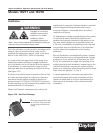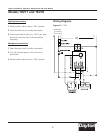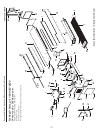
®
Dayton Installation, Operation, Maintenance and Parts Manual
Models 1RVT7 and 1RVT8
17
16
This infra-red heater must be vented in accordance with
national, state, provincial and local codes and the
guidelines throughout this manual. Refer to the latest
edition of the ANSI Z223.1 (NFPA 54) Standard.
It is required that the upper levels of the space to be
heated are properly ventilated to supply combustion
air to the heaters and to sufficiently dilute the products
of combustion. It is also important to keep the flue
discharge area clear of gas piping and electrical wiring
(see Figure 2.10).
Provisions must also be made to provide sufficient fresh
air intake area and exhaust air outlet area. Natural or
mechanical means shall be provided to supply and
exhaust at least 4.0 CFM per 1000 BTU/H of gas input.
Exhaust openings for the removal of flue products must
be above the level of the heater(s).
Where insufficient air movement exists, induced air
Ventilation
WARNING
!
Improper or insufficient
ventilation may result in
explosion, fire, health
problems, carbon
monoxide poisoning or
death. Vent enclosed spaces and buildings according to
national, state, provincial and local codes.
Figure 2.10 - Hot Flue Discharge
Discharge released from side
air channels. Keep area clear
of gas piping and electrical
wiring.
displacement is required. A balanced system is essential
to avoid negative building pressure which causes
excessive infiltration, unfavorable drafts and affects
combustion efficiency.
Air displacement may be accomplished by either gravity
or mechanical means. Mechanical exhausters are
preferred and typically mounted at high points on the
roof over where stagnant air accumulates inside. For
a flat roof, considerations of prevailing winds, high and
low pressure areas, and distribution of air movement
must be taken into consideration when locating
exhausters.
Best air distribution is accomplished by using a number
of small exhausters versus one large exhauster. Provide
a minimum of one square inch of inlet area per 1000
BTU/H for combustion air supply. Inlet opening in the
building should be well distributed, located high on the
wall and should direct incoming air upward to dilute
products of combustion while preventing drafts at lower
levels. Inlets are typically 1 to 3 sq. ft.
In certain applications, local codes may require that
mechanical exhaust systems be interlocked with the
heaters to enable both to function simultaneously or
allow control of exhausters with a ceiling mounted
humidistat.


















